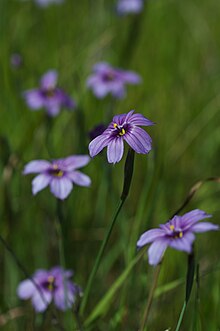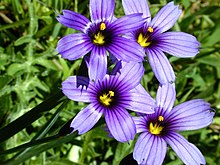| This article includes a list of general references, but it lacks sufficient corresponding inline citations. Please help to improve this article by introducing more precise citations. (October 2010) (Learn how and when to remove this message) |
| Sisyrinchium bellum | |
|---|---|

| |
| Scientific classification | |
| Kingdom: | Plantae |
| Clade: | Tracheophytes |
| Clade: | Angiosperms |
| Clade: | Monocots |
| Order: | Asparagales |
| Family: | Iridaceae |
| Genus: | Sisyrinchium |
| Species: | S. bellum |
| Binomial name | |
| Sisyrinchium bellum S.Watson | |
| Synonyms | |
| |

Sisyrinchium bellum, the western blue-eyed grass or Californian blue-eyed grass, is the common blue-eyed grass of California and Oregon in and west of the Sierra Nevada, its range extending south into Baja California. In parts of its range, western blue-eyed grass has previously been classified as Sisyrinchium eastwoodiae, S. greenei and S. hesperium, but these names are now considered synonyms.
Sisyrinchium bellum grows as a perennial plant in open places where there is some moisture, particularly grassy areas, though it can also be found in woodlands and at altitudes up to 2,400 metres (7,900 ft). Like other species of blue-eyed grasses that are locally dominant, it is generally known simply as "blue-eyed grass" within its natural range.
Description
The stems of Sisyrinchium bellum can grow as long as 60 centimetres (24 in), though they are often shorter. Its leaves are grassy and tufted. The flowers are 1–2 centimetres (0.39–0.79 in) in diameter and purplish-blue, varying somewhat in color from a true blue to a definite purple; occasional white-flowering plants are found. It flowers from March to July with a peak in April. Dried in air, its seeds weigh between 1 and 4 mg. After flowering, it dies to the ground and is dormant over the summer.
Cultivation
Sisyrinchium bellum prefers some moisture and good drainage, but will tolerate summer dryness. It can be propagated by seed, and it self-sows. It can also be propagated by division of its rhizomes, and the flower stems can be rooted. It is moderately hardy and will tolerate temperatures down to 20 °F (−7 °C).
Uses
The Ohlone used an infusion of the roots and leaves as a cure for indigestion and stomach pain, and similar uses are recorded from other Native American peoples.
References
- "The Plant List: A Working List of All Plant Species". Retrieved 8 July 2014.
- NRCS. "Sisyrinchium bellum". PLANTS Database. United States Department of Agriculture (USDA). Retrieved 16 November 2015.
- Sisyrinchium bellum at iNaturalist
- "Blue-eyed Grass". Presidio of California. National Park Service. Retrieved 1 October 2021.
- Harlow, Nora, Jakob, Kristin, and Raiche, Roger (2003) "Wild Lilies, Irises, and Grasses". University of California Press. ISBN 0-520-23849-4.
External links
 Media related to Sisyrinchium bellum at Wikimedia Commons
Media related to Sisyrinchium bellum at Wikimedia Commons Data related to Sisyrinchium bellum at Wikispecies
Data related to Sisyrinchium bellum at Wikispecies- Jepson Manual Treatment - Sisyrinchium bellum
- USDA PLANTS: Sisyrinchium bellum
- Sisyrinchium bellum in the CalPhotos photo database, University of California, Berkeley
| Taxon identifiers | |
|---|---|
| Sisyrinchium bellum |
|